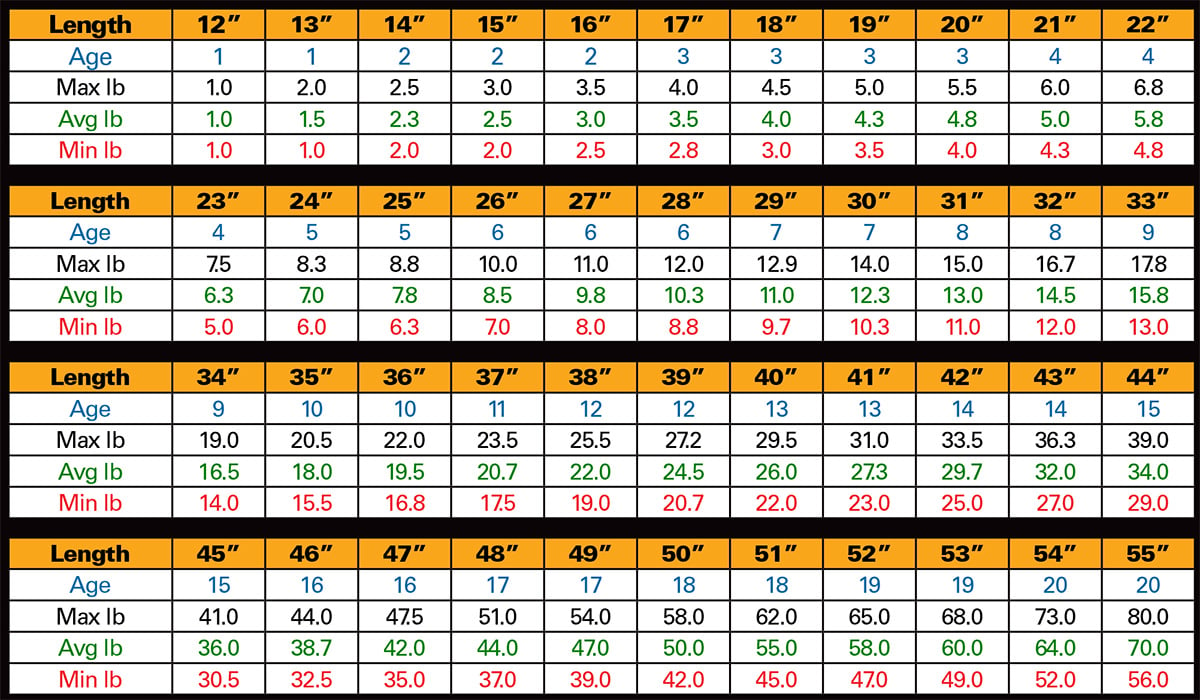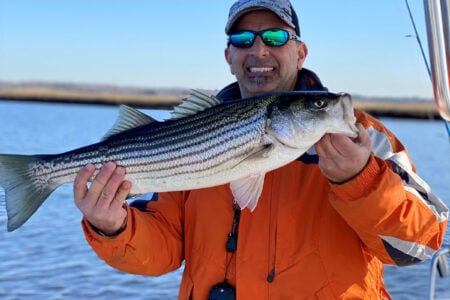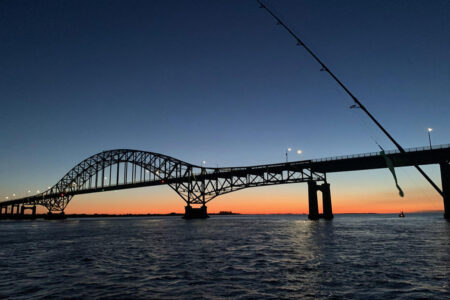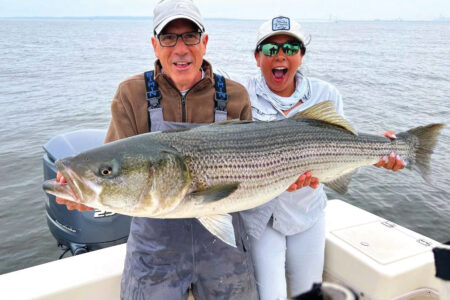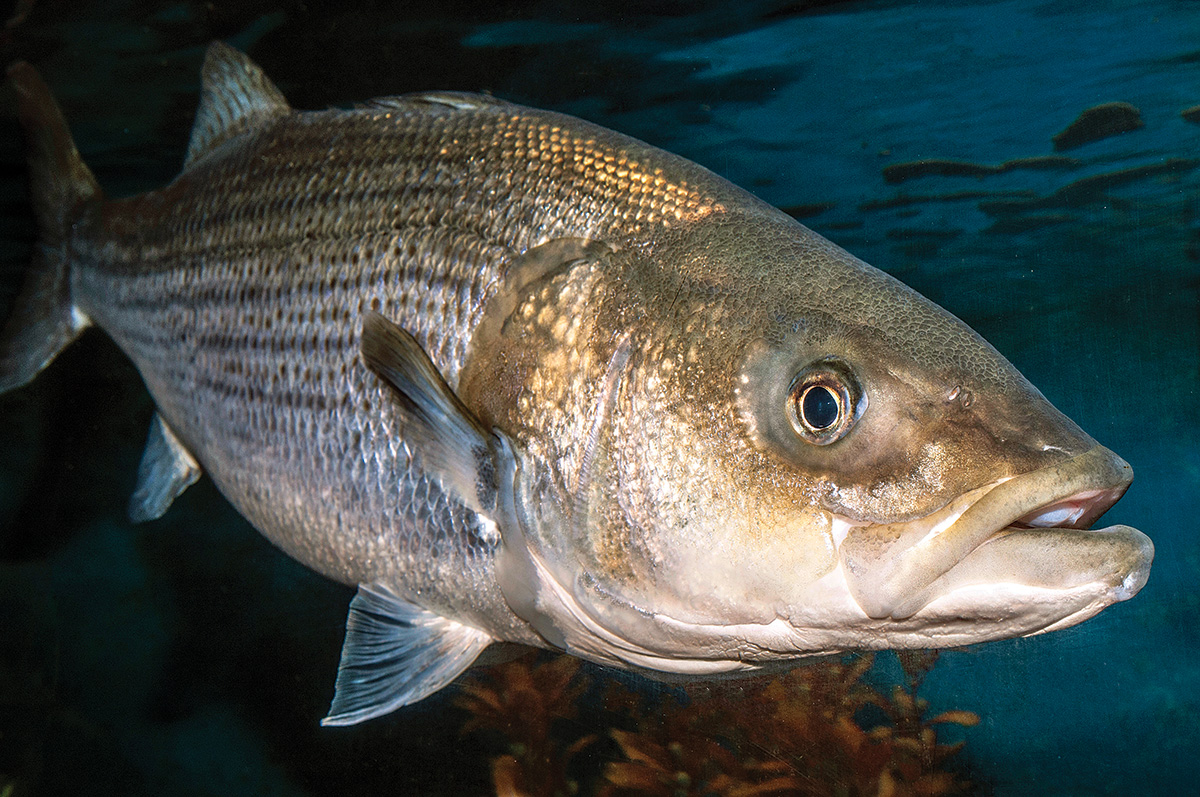
Here’s a revealing look at the life cycle and history of one of the most popular sportfish on the East Coast.
Each year usually starting in April, large schools of striped bass make their way north along the coast.Most make a journey of five hundred miles or more from Chesapeake Bay. Female striped bass can be over 4 feet in length and weigh 40 to 50 pounds. Striped bass never stop growing as they age. They can live up to 31years in the wild and attain weights of up to 100 pounds.The largest striped bass on record was caught in North Carolina in 1891 and weighed 125 pounds.
Fishermen along the Northeast Coast have eagerly sought striped bass since long before the advent of graphite rods and high-tech spinning reels. Many Native American tribes traveled to the coast to establish seasonal fishing villages. Striped bass were caught, along with other migrating fish, in wooden traps called weirs. When European colonists arrived, they were poorly equipped to farm New England’s thin rock soil. Striped bass, along with river herring and shad, became an important food source, as they were easily caught by the thousands in tidal creeks and estuaries.
Striped bass were considered so vital to the Massachusetts Bay colony that in 1639, their use as fertilizer was banned to force colonists to develop fishery commerce with Europe.The commercial value of striped bass became evident to New Englanders long before the American Revolution.In 1670, the members of Plymouth Colony dedicated the proceeds from a striped bass sales tax to help fund the construction of the first public school in the new world.

Today, the commercial and recreational fishing of striped bass is a multi-billion dollar industry.But it is an industry, which has come perilously close to collapse.As early as the mid-eighteenth century, striped bass populations along the East Coast had been known to crash suddenly and dramatically.Regulations and prohibitions against winter fishing or sale of striped bass went into effect in New York in 1758 and in Massachusetts in 1797.
By the mid-nineteenth century, a pattern of decline was beginning to become evident in spots throughout New England, despite abundant stocks elsewhere. By the late nineteenth century, the number of stripers all along the Northeast Coast had fallen dramatically. The turn of the twentieth century saw the days of abundant striped bass become a distant memory.While no one can be certain as to the cause of this catastrophic decline, a number of factors stand out.
As the United States grew into an industrial giant during the course of the nineteenth century, the coastline from the Mid-Atlantic States to Maine became increasing developed.This lead to an inevitable loss of critical spawning and nursery habitatby the construction of dams. Pollution, particularly raw sewerage dumped directly into rivers by the growing populations of eastern seaboard cities, was also very likely a factor.
But it was almost certainly overfishing that did the greatest damage to striped bass stocks. From the earliest days, mortality from fishing outstripped their ability to reproduce. That it took over two hundred years to nearly fish them out is testament to their previously enormous abundance.

Range
Striped bass were originally found along the east coast from the St. John’s River in Florida to the Gulf of St. Lawrence, and on the gulf coast, in the Apalachicola River.
South of the Mid-Atlantic States, striped bass spend most of their time in rivers during summer when water temperatures are high in tidally influenced (saltwater) sections of the river and move into tidally influenced sections when water temperatures drop. The West Coast has an established population, having been introduced into California as an exotic species in the late nineteenth century. Landlocked populations have also been established in thirty-one states across the country.
The largest concentrations of striped bass are found in the area from the Mid-Atlantic States through southern New England, ranging from North Carolina to the southern Gulf of Maine. Principal spawning areas include Chesapeake Bay, the Hudson River, the Delaware River and the Roanoke River/Albemarle Sound area.
The Chesapeake Bay area is by far the single most important spawning ground for striped bass. The bay’s many tidal estuaries and backwaters provide a vast amount of natal and nursery habitat. The broad, shallow bay itself is a fertile feeding ground for juvenile rockfish.Both historically and currently, the bay provides 70 to 80 percent of the east coast migratory population when abundance is high. The Hudson River contributes an additional 10 percent and the Delaware Bay area around 20 percent. Since striped bass rely so heavily on Chesapeake Bay during the critical early stages of their lives, protection of this vital habitat has been a key factor in establishing healthy population levels.
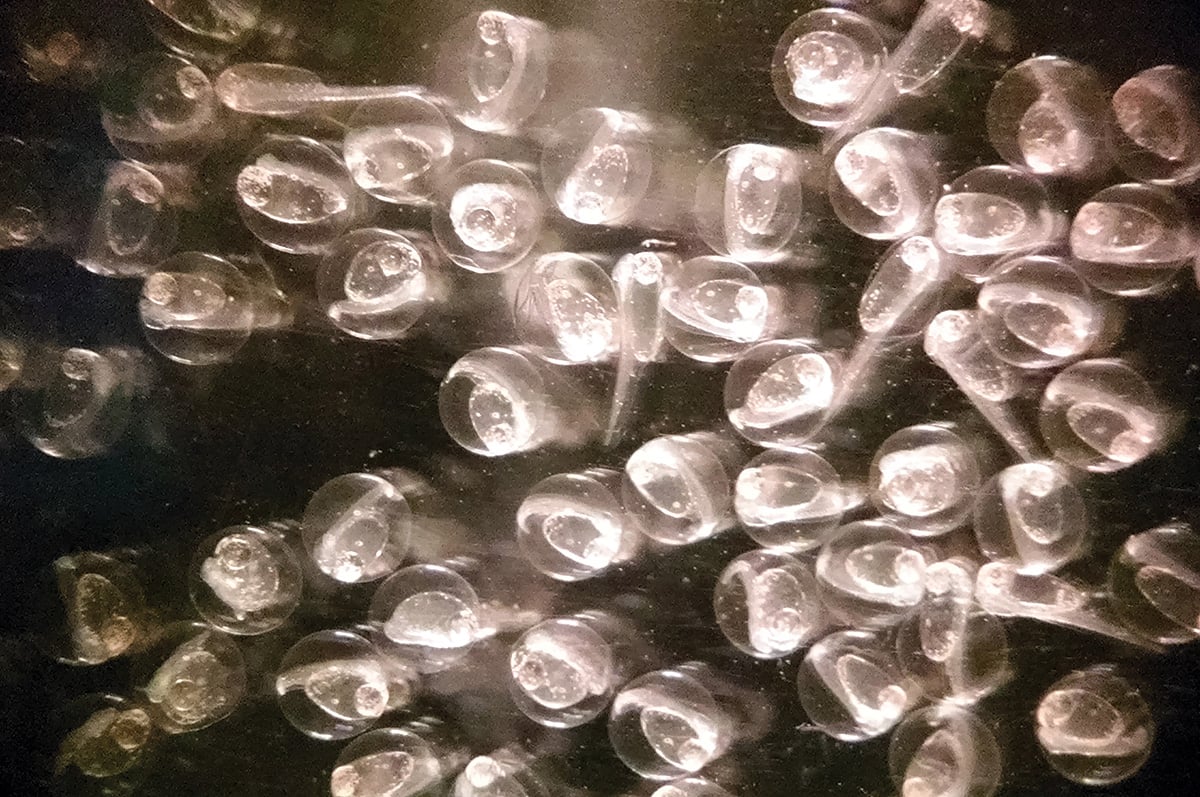
Migration/Lifecycle
Striped bass is somewhat of a mystery fish. Much of its complex behavior was poorly understood until recently. Much remains unclear. Not all striped bass behave the some way at the same age. For example, while about 50 percent of females reach sexual maturity by 4 or 5 years of age, the remaining half take 6 to 9 years to mature.Males, however, generally mature 50 percent earlier, at 2 years old, while 75 percent mature at age 3 and 100 percent by the age of 4.
Migration patterns are similarly complicated. The journey taken by an individual striper is subject to a number of variables.Striped bass (rockfish) south of North Carolina are non-migratory.Canadian stocks of striped bass make short, localized migrations along the coast. The general pattern of migration for most mid-Atlantic striped bass is for mature adults to gather during the winter months off the Virginia and North Carolina coasts. They remain there until mid-spring, when they return to their natal rivers to spawn.
Soon after spawning, adults leave freshwater and travel north along the coast. Females generally travel faster than males. But since males mature earlier than females, they join the coastal migration several years sooner.For some, the destination is the waters of coastal New Jersey or New York.Many enter Narragansett Bay in Rhode Island.But most spend the months of summer and early autumn feeding near the islands of Martha’s Vineyard and Nantucket, near Cape Cod or in the southern Gulf of Maine.Some travel as far as the northern Gulf of Maine or into the Bay of Fundy.
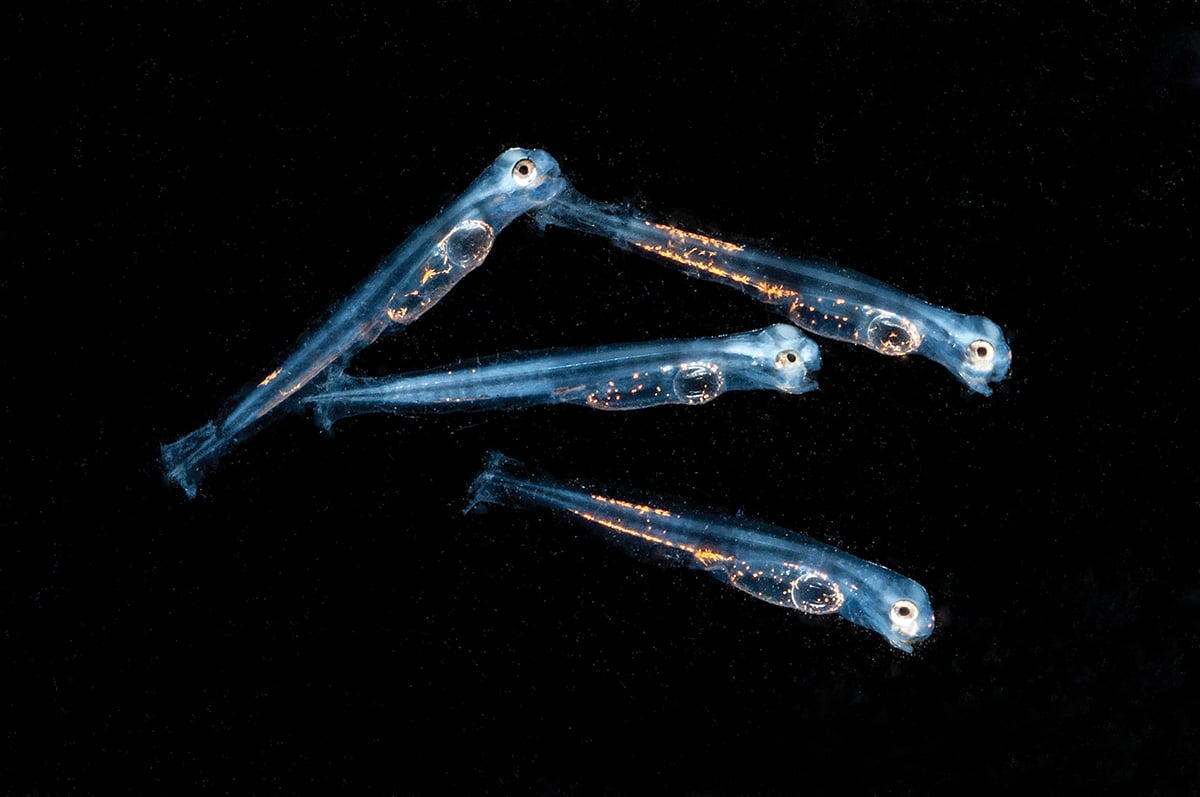
By mid-autumn, the migration is reversed, and the stripers return south once again. A few fish remain in northern waters, over wintering in isolated pockets all along the coast, then returning to spawn in the spring.Some Delaware and Hudson River fish travel only as far as the waters off of the New Jersey coast. But most fish of all stocks return to the Mid-Atlantic overwintering grounds.
By early April, mature striped bass have begun to move into the mouths of their natal rivers. While some may travel as much as two hundred miles upstream, most spawn in the slightly brackish or freshwater sections just above the upper estuaries of large rivers, in waters less than 20 feet deep.Water temperature is the key factor in determining when spawning occurs. Peak spawning activity occurs when the water is about 60 to 65 degrees. This generally occurs from mid-April to mid-May in the Mid-Atlantic region. Spawning is usually completed in all regions by the end of June or early July.
Females release their eggs at or near the surface as nearby males release milt to fertilize them.As they grow older and larger, the number of eggs released also grows. A female rockfish in her first spawning season releases about four hundred thousand eggs. Towards the end of their natural life span, a large, healthy female can distribute ten times as many, releasing over four million eggs in a single season. Similar to many other types of fish, striped bass release large numbers of eggs to offset intense predation. During early life stages, they are preyed on by many other species.
But striped bass eggs have an additional obstacle to overcome. In order to successfully hatch, they must remain suspended in the water. Since striped bass eggs are slightly heavier than water, they begin to sink slowly as soon as they are laid. Any eggs that fall to the bottom, are unlikely to hatch. The eggs depend on sufficient river current and tidal flow to keep them suspended.
Each egg contains a yolk sac, which provides nutrition for the developing embryo, and an oil globule, which also feeds the growing fish. Eggs of striped bass that spawn in slow moving rivers have a slightly larger oil globule, making them more buoyant and more likely to stay suspended long enough to hatch success fully.
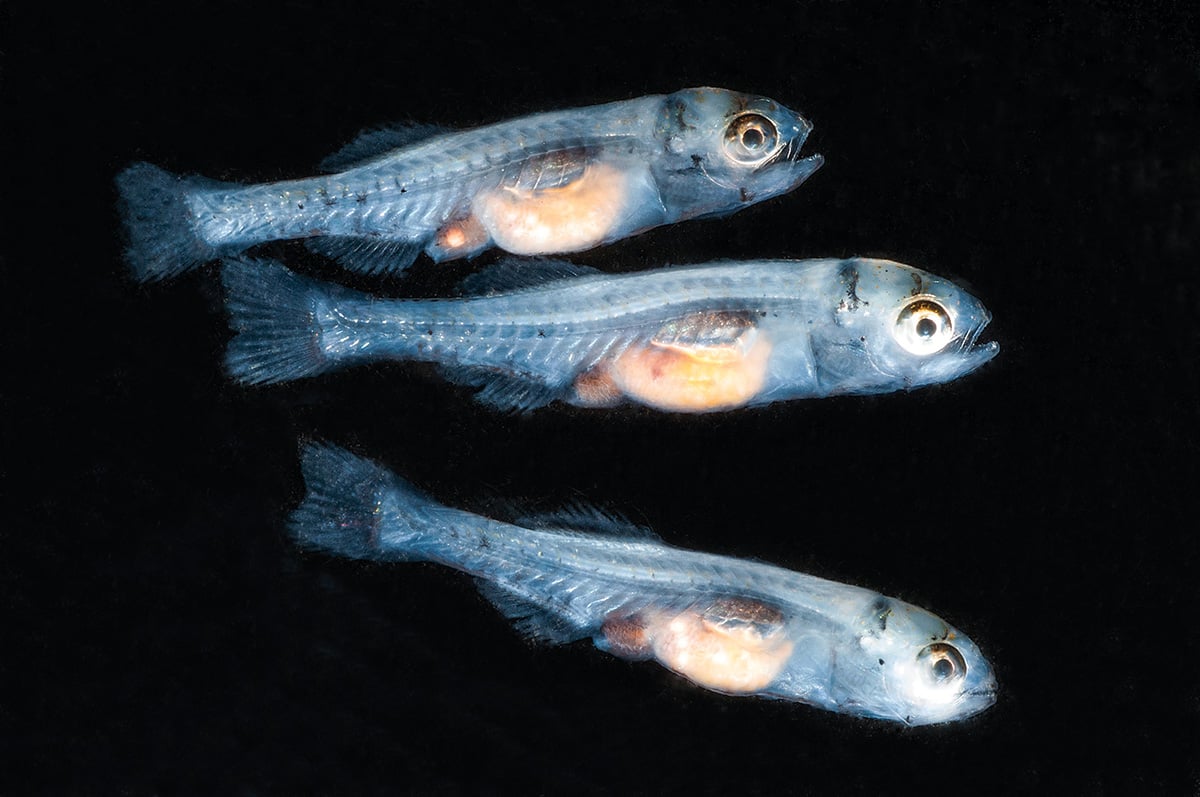
Eggs, which remain afloat, hatch in one and a half to three days, again, depending on water temperature.The eggs hatch to release larvae, which are about one-quarter of an inch long. The attached yolk sac and oil globule continues to feed the larvae for about a week.They then begin to feed on microscopic organisms called zooplankton, which are suspended in the water.Larvae continue to feed in the open water of their natal river for four to six weeks, drifting slowly downstream.
When the young have grown to be about 1-1/4 inches long, they develop into the juvenile stage and more closely resemble adults. They begin to exhibit schooling behavior, forming groups of as many as several thousand fish.
As the summer months pass, they move downstream into saltier water, inhabiting the inshore tidal creeks of the upper to mid-estuary.
Migration patterns for older juveniles vary with location. In most coastal areas, the young of the year move into the lower estuary during their first autumn and spend the winter months there or in the adjacent offshore waters.Sub-adults from the Hudson and Delaware rivers develop a pattern of moving generally north and east during the spring and summer, then south and west during the fall and winter, traveling further and further each year. Upon reaching sexual maturity, many join the offshore migration from North Carolina in the winter to New England in summer. Others retain the more local migratory pattern, gathering off the coast of New Jersey in winter.
In the Chesapeake Bay area, immature rockfish remain in the tidal freshwater or brackish stretches of their natal river for two years. During the spring of their second year, they move through the lower estuaries into the open bay, moving generally north during the summer.By autumn, they move inshore and southward, settling into the deep channels of the lower bay during winter.Recent research has shown that a few immature sub-adults travel further south; leaving the bay to join migrating adults gathered off the Virginia and North Carolina coasts. In the spring, they follow adults returning to spawn back into the bay. Some Chesapeake Bay males begin offshore migration during their first season in saltwater. The majority of fish in Chesapeake Bay during summer are mature males. Females continue to migrate within the bay for three to seven additional years before achieving spawning age, with many immature females migrating to the coast.
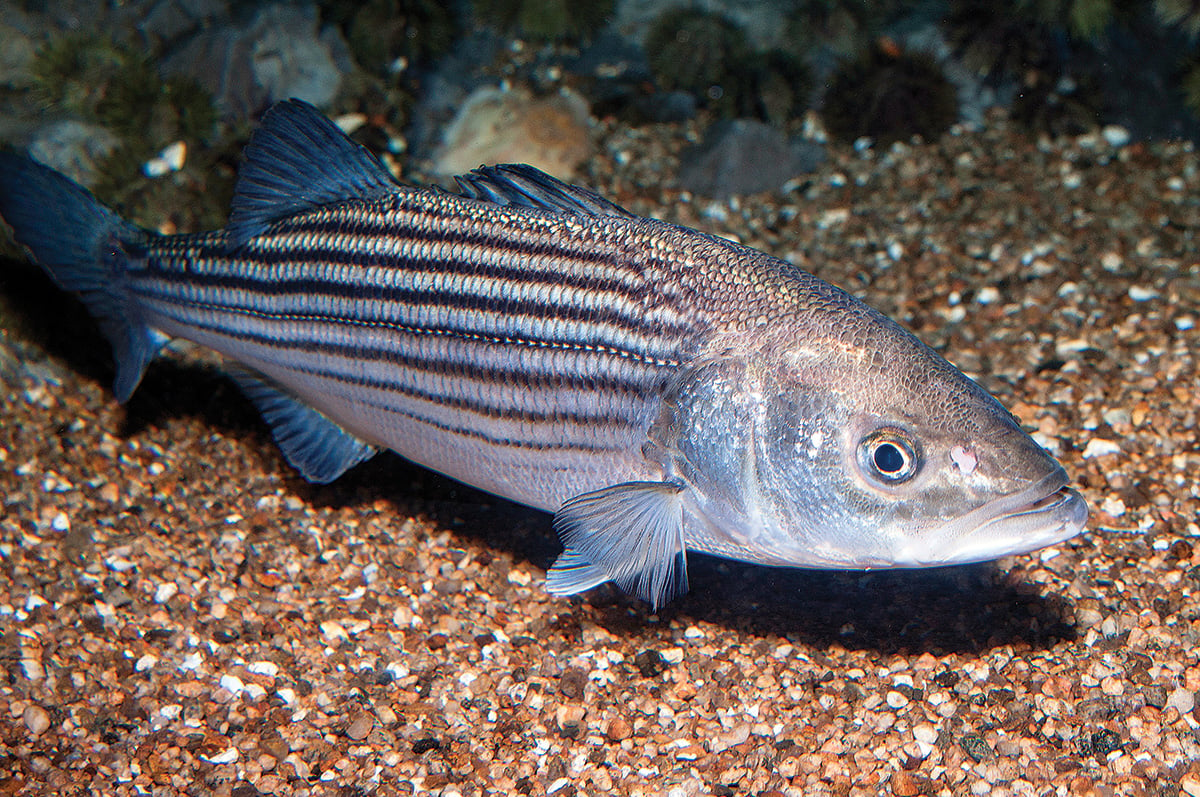
| SIDEBAR: STRIPED BASS AGE/LENGTH/WEIGHT CHART |
|---|
|
The overall accuracy of this chart is considered good. Note that at the upper end of the chart, size to weight can vary dramatically and accuracy is diminished. The majority of fish over 30 pounds are females and they have been known to live as long as 30 years. Weights in the spring months are generally lower. Chart courtesy of Twin Lights Marina.
|
